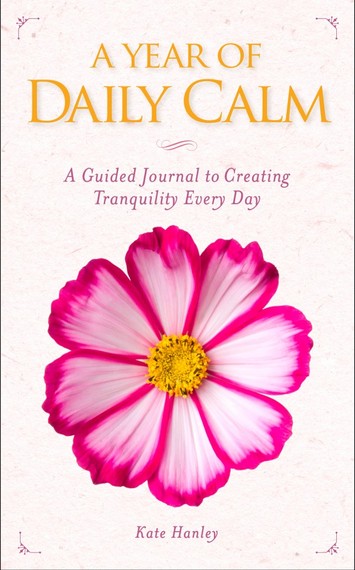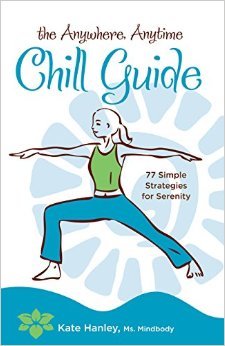At a recent holiday get together -- full of wonderfully high-powered women who were stressed over the holidays and other aspects of life -- I met Kate Hanley, clearly the calmest person in the room. What's her secret? She has more than one. Kate handed me her new book, A Year of Daily Calm, published by National Geographic (hence, the exquisite and calming nature photos that accompany the brief reflections, handy tips and sage advice) and I knew I had to try her tips.
While self-help can often complicate our lives with to-do lists and "shoulds," as a life coach, Kate knows how unhelpful and stressful those lists can be. A Year of Daily Calm finds the sweet spot that makes it possible to shift into calm with a gentle ease, and offers you space to take notes or journal. It's NOT another item to put on your list and check off.
In this interview, Kate Hanley shares how "calm" is truly possible, why we need it more than ever, and how to welcome calm into our hectic lives. After working through some of the exercises I can say it has the potential to be a game changer.
Lisa: With everything going on in our lives, and in the world in general, people may not believe they can be calm on a daily basis. How would you respond to someone who finds it hard to imagine?
Kate: You only have so much control over the stressors you're exposed to, but you absolutely have a say in how you respond to those triggers. The catch is, you've got to spend some time building your calm muscles, because the human brain is wired to look for problems and focus on what's going wrong -- it's called the negativity bias. If you don't actively cultivate more calm in your life, you'll get stuck in stress mode and that feeling of being at peace will get more and more elusive for you.
I'm not suggesting that you can be eternally Zen. I am saying, devote some amount of time on a mostly regular basis to cultivating calm, and you will begin to notice that your buttons don't get pushed quite as frequently or as strongly as they once did. You'll enjoy your own company more, as will the people you come in contact with. You'll help others find their own inner calm, simply by modeling the way. It's a lovely ripple effect that reaches well beyond your own self.
Lisa: When you say "Daily Calm" what does that mean to you? We probably don't want to "strive" for calm, but what are we aiming for?
Kate: To me, daily calm equals quiet time. The quiet itself may only last for a few minutes -- or even only a moment -- but that reduction of mental noise creates effects that stick with you all day. When you're stuck in traffic and are late for work, you'll be more likely to remember to take a deep breath or two before you start shouting at the other drivers because you took a little time for yourself that morning to savor a few sips of your tea, or to sit and focus on the sound of your breath.
Even though that quiet moment has passed, by taking it, you create a force field around yourself that helps you reflect -- even for just an instant -- before you respond, for hours afterward.
Lisa: The title of your book is A Year of Daily Calm. What happens if you miss a day, or a week? Do you have to start over?
Kate: I know you're going to miss a day -- and it's totally fine. While the exercises in the book are laid out according to monthly themes that build on each other, they only occur every few days. Meaning, there are many days when your whole "Daily Calm" assignment is to take in a beautiful photograph and an inspiring quote.
You could easily miss a week, or even several weeks, and get right back in to the flow. You can catch up on the things you missed, or let them go and catch up on them next year. Because calm isn't "set it and forget it," the book is designed so you can use it year after year and keep cultivating your ability to find that sense of calm.
Lisa: How did you develop the exercises for A Year of Daily Calm? Do they build on one another, or can you start anywhere?
Kate: Both. It's ideal if you can start in January and work your way through the monthly themes, because they are designed to flow from one in to the other in a way that makes sense. But this is the real world. You may not even discover the book until May, and you can dive right in to that month without missing a beat. There's no law that says that the only appropriate time to start a year-long project is on Jan. 1. May 1 through April 30 is still 365 days.
Lisa: How do you foresee people using A Year of Daily Calm?
Kate: I imagine them keeping it near the chair where they drink their morning coffee and using it to "take a moment" before the day gets rolling. Or, keeping it on their bedside table and using it to process their day and get their mind focused on something uplifting before they turn off the light and go to sleep.
It's also a great book to share with friends -- that way, you'll have someone else in your life whom you can talk to about the stuff you'll cover in the book. Sharing is not only caring, it also gives your ideas power by getting them out of your head and in to the world.
A Year of Daily Calm would make an excellent selection for a book group -- you could spend a few minutes of each meeting talking about that month's theme and sharing one takeaway from that month, for example.
Lisa: I specialize in working with writers, authors, entrepreneurs. So, I'm curious, as an author and freelancer, how you put the tools in your book into practice in your own life and writing practice. Were there specific exercises you tended to do? And how did they help your creative process as a writer? How did they help your consistency in writing?
Kate: In the book, I write about using your daily chores as a kind of mind-body practice -- allowing yourself to get absorbed by the act of cooking dinner, or sweeping the floor, so that your mind quiets. As I was writing this book, I realized just how important my "procrastination" techniques are to my creative process, and I lost a lot of the guilt I had around stepping away from my desk in the middle of the day to prep veggies for dinner or fold a load of laundry.
When I got more intentional about those tasks, I found that I nearly always had some flash of inspiration while doing them. The clarity of thought I experienced while doing my chores made it easy to dive back in to the flow of writing when I got back to my desk -- an idea for how to close a section, or a title for an exercise, for example.
I also talk about the importance of spending time with people who are as happy or happier than you are, because states of mind -- just like germs -- are contagious. While I had done this in my personal life, I realized there were still a lot of ways I was exposing myself to a common writer's mindset that the industry is changing, it's harder to make a living, and the sky is falling. Making this shift helped me keep looking for opportunities instead of only noticing the closed doors. It also inspired the way I market myself -- I've been taking a much more active role in creating materials, such as videos, that help me reach new audiences, instead of simply following the old model of sending out queries and waiting to get picked.
Lisa: Are there other ways that writing the book and doing the practices helped you as a writer?
Kate: As a rule, the more connected I am to myself and what I know to be true for me, the better I write. Every one of these practices helps me tune out the doubts that every writer experiences and write what I know.
Lisa: Your first book was The Anywhere, Anytime Chill Guide. How did you come to specialize in writing about stress reduction?
Kate: Since my first job out of college, I worked as an editor -- I figured it was the best way to be able to spend my time reading and writing while still earning a living. I practiced yoga on my lunch hour or after work to help me deal with the stresses of my jobs. It honestly never occurred to me that I could be a professional writer until I enrolled in a year-long yoga teacher training in my mid-30s -- we had to commit to practicing at least three times a week and meditating on our own at home. All that time on the mat and the cushion helped me hear that what I really wanted to do was write. Since then, I've focused on writing about all things wellness as an homage to where I found the inspiration to write professionally.
Plus, they say we teach what we need to learn. As an entrepreneur, mother to two young kids, and reformed New Yorker (where I lived for 15 years before moving to Providence, RI), I knew a lot about having a million things on your plate and needing to find powerful ways to cope with stress that didn't take a lot of time.
Lisa: What are some of the benefits of actively doing things to create more calm in your life?
Kate: You know what's worth spending your time and energy on, and what's not.
- You're less likely to create unnecessary stress for yourself because you're less likely to over-react.
- You create the conditions you need to do your most inspired thinking, making you more creative.
- Your body becomes less tense, meaning your daily aches and pains lessen.
- You give your nervous system the chance to shift out of fight-or-flight mode and into rest-and-digest mode, so you become more resilient, better rested, clearer-headed and in better physical and emotional health.
Lisa: That's pretty convincing! What do you wish everyone knew about reducing stress?
Kate: You don't have to go to a 90-minute yoga class or pay for a $150 massage to do it. Little bits of time -- done with as much consistency as you can muster -- yield massive results.
Lisa: What do you do on crazy busy days to stay calm?
Kate: I do a little yoga in the kitchen while the water for my tea heats up; or meditate for five minutes in the car after I arrive at the kids' school but before I head in to pick them up; or go on as long a walk as I can manage -- even if it's just around the block -- and let myself take in the sky so that my perspective opens up; or lie on the floor in corpse pose for 10 minutes before I get in bed. Sometimes it's a combo of these things, sometimes it's just one.
My motto is: More is better, but some is always better than none.


